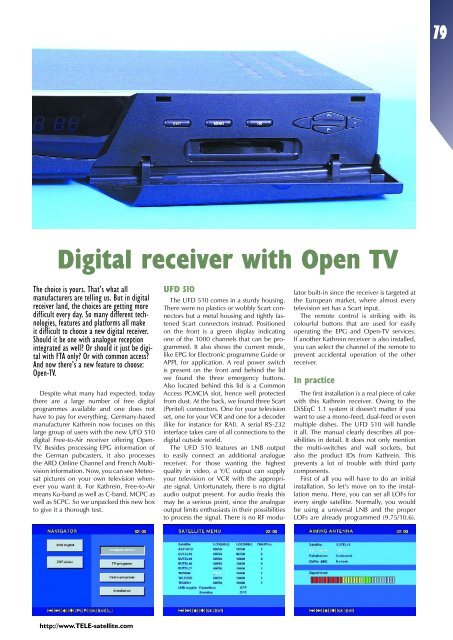TELE INTERNATIONAL - TELE-satellite International Magazine
TELE INTERNATIONAL - TELE-satellite International Magazine
TELE INTERNATIONAL - TELE-satellite International Magazine
Create successful ePaper yourself
Turn your PDF publications into a flip-book with our unique Google optimized e-Paper software.
Digital receiver with Open TV<br />
The choice is yours. That’s what all<br />
manufacturers are telling us. But in digital<br />
receiver land, the choices are getting more<br />
difficult every day. So many different technologies,<br />
features and platforms all make<br />
it difficult to choose a new digital receiver.<br />
Should it be one with analogue reception<br />
integrated as well? Or should it just be digital<br />
with FTA only? Or with common access?<br />
And now there’s a new feature to choose:<br />
Open-TV.<br />
Despite what many had expected, today<br />
there are a large number of free digital<br />
programmes available and one does not<br />
have to pay for everything. Germany-based<br />
manufacturer Kathrein now focuses on this<br />
large group of users with the new UFD 510<br />
digital Free-to-Air receiver offering Open-<br />
TV. Besides processing EPG information of<br />
the German pubcasters, it also processes<br />
the ARD Online Channel and French Multivision<br />
information. Now, you can see Meteosat<br />
pictures on your own television whenever<br />
you want it. For Kathrein, Free-to-Air<br />
means Ku-band as well as C-band, MCPC as<br />
well as SCPC. So we unpacked this new box<br />
to give it a thorough test.<br />
http://www.<strong>TELE</strong>-<strong>satellite</strong>.com<br />
UFD 510<br />
The UFD 510 comes in a sturdy housing.<br />
There were no plastics or wobbly Scart connectors<br />
but a metal housing and tightly fastened<br />
Scart connectors instead. Positioned<br />
on the front is a green display indicating<br />
one of the 1000 channels that can be programmed.<br />
It also shows the current mode,<br />
like EPG for Electronic programme Guide or<br />
APPL for application. A real power switch<br />
is present on the front and behind the lid<br />
we found the three emergency buttons.<br />
Also located behind this lid is a Common<br />
Access PCMCIA slot, hence well protected<br />
from dust. At the back, we found three Scart<br />
(Peritel) connectors. One for your television<br />
set, one for your VCR and one for a decoder<br />
(like for instance for RAI). A serial RS-232<br />
interface takes care of all connections to the<br />
digital outside world.<br />
The UFD 510 features an LNB output<br />
to easily connect an additional analogue<br />
receiver. For those wanting the highest<br />
quality in video, a Y/C output can supply<br />
your television or VCR with the appropriate<br />
signal. Unfortunately, there is no digital<br />
audio output present. For audio freaks this<br />
may be a serious point, since the analogue<br />
output limits enthusiasts in their possibilities<br />
to process the signal. There is no RF modu-<br />
lator built-in since the receiver is targeted at<br />
the European market, where almost every<br />
television set has a Scart input.<br />
The remote control is striking with its<br />
colourful buttons that are used for easily<br />
operating the EPG and Open-TV services.<br />
If another Kathrein receiver is also installed,<br />
you can select the channel of the remote to<br />
prevent accidental operation of the other<br />
receiver.<br />
In practice<br />
The first installation is a real piece of cake<br />
with this Kathrein receiver. Owing to the<br />
DiSEqC 1.1 system it doesn’t matter if you<br />
want to use a mono-feed, dual-feed or even<br />
multiple dishes. The UFD 510 will handle<br />
it all. The manual clearly describes all possibilities<br />
in detail. It does not only mention<br />
the multi-switches and wall sockets, but<br />
also the product IDs from Kathrein. This<br />
prevents a lot of trouble with third party<br />
components.<br />
First of all you will have to do an initial<br />
installation. So let’s move on to the installation<br />
menu. Here, you can set all LOFs for<br />
every single <strong>satellite</strong>. Normally, you would<br />
be using a universal LNB and the proper<br />
LOFs are already programmed (9.75/10.6).<br />
79

















